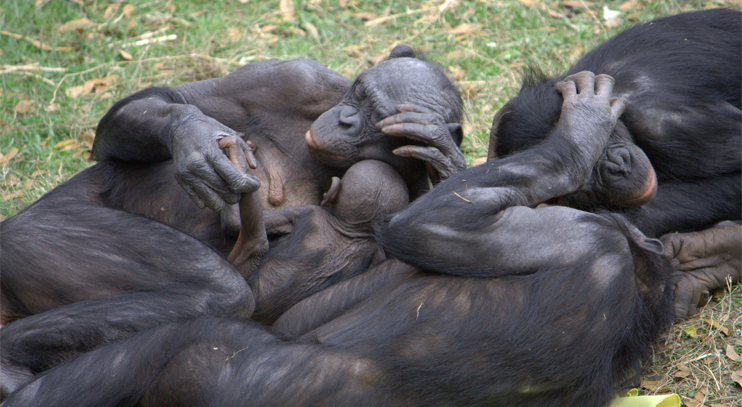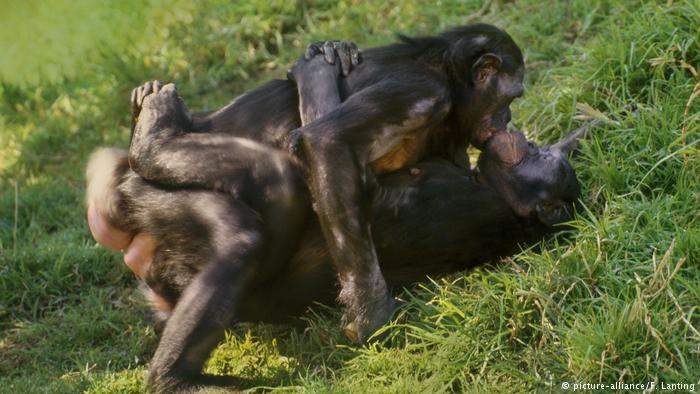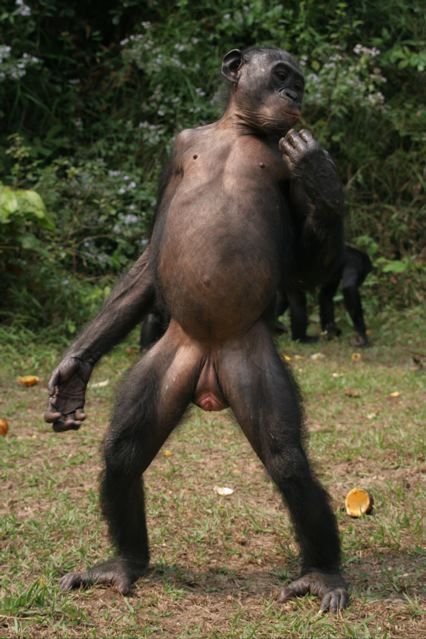Bonobos are humans’ peace-loving cousins, a little known primate only discovered in 1928. Once thought to be small chimpanzees, bonobos are actually an entirely different species. Bonobos share the same percentage of our DNA (98.7%) as chimpanzees do, making chimpanzees and bonobos our closest relatives.[1] But while chimpanzee society is a “dominator” culture, bonobos demonstrate a “partnership” society, with remarkable cooperation and peacemaking capacity.[2] Bonobos prove that humanity holds the genetic potential to go in either direction.

In over twenty years of research, there has yet to be one instance of intergroup killing by bonobos, which is so common with chimpanzees. When two groups of bonobos meet, the males stand and posture, waving sticks and baring their teeth. But the females from both groups immediately gather together and start sharing food or grooming each other, diffusing the tension. With the females now bonded, the males can do nothing but acquiesce to the new peace – a perfect demonstration of how bonded females can take control.
There is no infanticide in bonobo groups, likely because there is no way of discerning paternity. A male bonobo could never be sure he wasn’t killing his own child due to bonobos’ nonstop sexual exploits. In fact, male bonobos will babysit and interact with little ones even though they don’t know whether it is “theirs.” Young bonobos stay with their mothers for five years in a prolonged childhood – and sons basically never leave their mothers. By contrast, male chimpanzees leave their mothers to bond with other males.

Bonobos live in a kind of matriarchal society. Females get first access to food and resources and form strong bonds by sharing food and sexual activity like tribadism (rubbing genitals with or on each other for a period of 10-20 seconds, which females do every two hours on average). Female-to-female genital rubbing is actually the most common kind of bonobo sex.[3] While the males are physically stronger, they lack the bonded group that females form, and therefore their occasional attempts to dominate fall flat. From the BBC documentary The Last Great Ape: “Males want to muscle in but if females stand united the males remain under their collective thumb.”[4] The sons of powerful females in the group have higher social status – but once their powerful momma passes away, they immediately lose it.
When there is tension, sex is used to diffuse the situation. There is amazing footage in The Last Great Ape, where a male bonobo is running towards another male aggressively waving a large stick. Mid-charge he comes across female bonobo on all fours – so he drops his stick for a quick shag. Anger is forgotten as they make love and not war.
In fact, sex permeates bonobo society and has all number of social functions. It’s similar to a handshake or hug: it can be a greeting, reconciliation, bonding between females or even between mother and child. Because sex has all number of social functions, it is used in all possible combinations. Bonobos have every kind of sex: gay, straight, masturbation, tongue kissing, and oral sex. They even have sex face-to-face (rare in the animal kingdom), and they have much gentler sex than chimpanzees. In a group, a female will have had sex with all the males. This constant sexual interaction creates calm in bonobo life – intimacy makes it hard to stay angry.

Bonobos give insight into the lineage of cooperation and partnership societies that likely existed farther back in pre-agricultural hunter-gatherer times. They share with humans the DNA that is correlated with affiliation and bonding, and which chimpanzees lack. How telling that our patriarchal society has found justification for its own behavior in the world of chimpanzees – when actually humans are at least equally related to bonobos. We resemble them more physically as well. Like humans, bonobos have more distinct faces, longer legs, pronounced breasts, and larger penises – although as science journalist Natalie Angier notes, a female bonobo weighing perhaps half that of a human teenager “has a clitoris that is three times bigger than the human equivalent – and visible enough to waggle unmistakably as she walks.”[5]

Unfortunately bonobos are very difficult to study because they are an endangered species, only about 30,000 of them remain in all in the jungles of the Congo, where they are hunted for bush meat as well as the pet trade. Researchers have barely had a chance to study them in recent years because of warfare and uncertainty in the region. But there seems to be so much hope in this cute cousin of ours.
Riane Eisler theorizes that there are two strands of our evolution: “dominator” culture based on fear and pain and “partnership” culture based on pleasure. I often find Eisler’s work problematic (if well-meaning), particularly in regards to her opinions on sex work, pornography, BDSM and kink. However, in her book Sacred Pleasure she stresses that “bonobos demonstrate an evolutionary movement toward sex as a means of reinforcing social relations based on the give and take of shared sensual pleasure rather than on coercion and fear.”[6] When tension arises, bonobos are masters of using sex as peacemaking ritual – using female bonds and a wide variety of sexual interactions to settle disputes and prevent violence.
Knowledge of these peaceful cousins is potentially empowering for humans – especially since the worst of human nature has been explained away by genetics in the past (with chimpanzee society presented as the evidence). The more I read about bonobos the more I see the importance of their discovery for our evolutionary understanding.
Imagine if we all became masters of using sex as peacemaking, healing and spiritual ritual. It may not be practical or desirable for a women to go down on all fours with her skirt raised in between two blokes to prevent a fight – but what an impressive image of potential female sexual power.
🖤 🖤 🖤
For more on bonobos, I highly recommend watching the PBS documentary “The Last Great Ape”
🖤 🖤 🖤
[1] Mooney, “You Share 98.7 Percent of Your DNA With This Sex-Obsessed Ape.”
[2] Eisler, The Chalice and the Blade, 34–52.
[3] Waal, “Bonobo Sex and Society.”
[4] Greenwood, The Last Great Ape: Missing in Action.
[5] Angier, Woman, 68.
[6] Eisler, Sacred Pleasure, 42.


